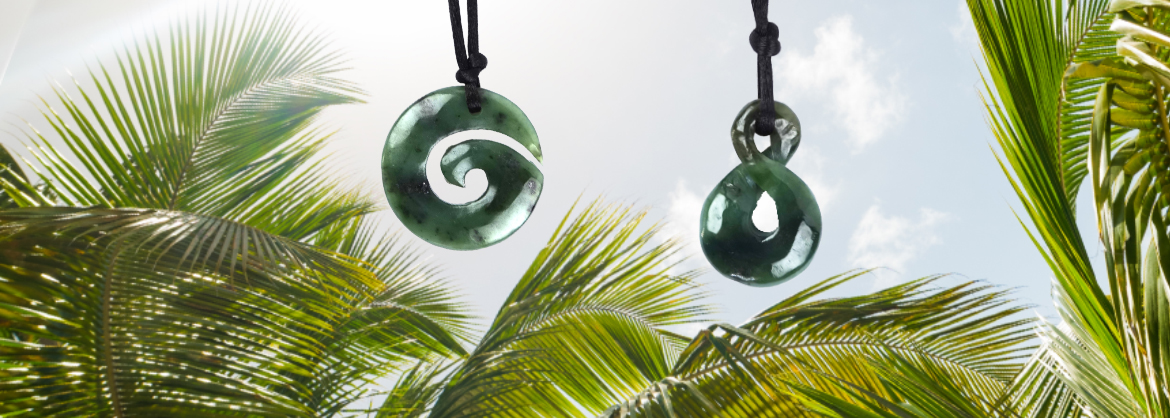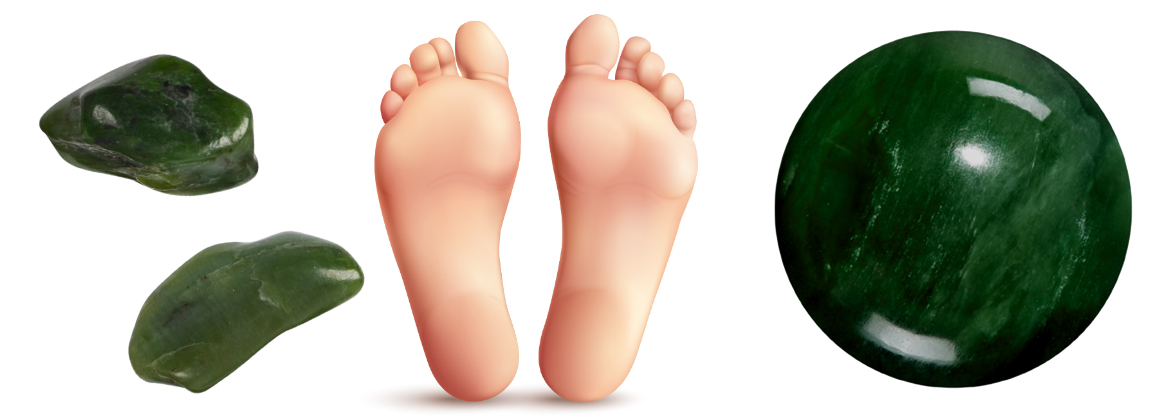
Stone of the Month November 2025: Nephrite Jade - Bearinge and meaning
Nephrite helps not to get lost. Indecisiveness is overcome, we remain thanks to the stone capable of action and creative. Neutrality and tolerance are supported, tensions are reduced - so Nephrite can be a helpful companion when the danger of a brooding mood arises in cold and dark times. Nephrite is also considered a good companion to overcome grief more easily, helping to positively resolve brooding doubts.
Tumbled stones, drilled focal components, donuts and stones for well-being for retailer
Mineralogical profile of Nephrite
Chemical Formula: Ca2(Mg,Fe)5(Si8O22)(OH,F)4+ OH,F
Mineral class: Chain silicates, Actinolite family.
Color: Green
Gloss: Glass to fat gloss.
Crystal system: monoclinic
Mohs hardness: 6 to 6.5
Cleavability: perfect in the longitudinal direction.
Localities: Australia, Canada, China, Germany, Great Britain, Guatemala, Indonesia (see below for details), Japan, Mexico, New Zealand, Poland, Russia, Switzerland, USA (Alaska).
Formation: metamorphic during formation of actinolite shales
Nephrite - Nephrite jade - Jadeite
The term "Jade" is not clearly assigned to a mineral, but is used for various green gemstones, mostly made of Nephrite or Jadeite. The term was adopted from French around 1800 and in turn goes back to the Spanish term ijada for "soft, flank". In the compound piedra de la ijada it means flank, loin stone, because already the Spaniards discovered that (Nephrite) jade was used by the natives of Latin America as a protective stone for the kidneys etc.. Underlying the Spanish expression is the Latin term. īlia (plural) "stomach, intestines, the soft"
In Chinese, the term "Yù" (玉) is commonly used for a "royal stone", something very noble and expensive that was accessible only to the emperor and high nobility. The Chinese character shows the close relation to the king, because it consists essentially of its symbol: "Wáng" (王). Jade was considered the emperor's sign in China for thousands of years and was used for fine carvings and as an engraving stone for the imperial seal.
In Europe, a number of different minerals are incorrectly referred to as "jade," such as Nephrite, Serpentine (China jade), Prase (African jade), Jadeite, and Chloromelanite (Maw Sit jade). The International Mineralogical Association (IMA), the non-profit scientific association for the advancement and support of mineralogy, therefore does not recognize jade as a distinct, clearly defined mineral. In a narrower sense, jade is the term used to describe those gemstones, which have a certain property: The constituents must be in microcrystalline form, i.e., as matted fibers or grains detectable only with a microscope. This is true for Nephrite and Jadeite; both have a very high toughness and fracture toughness. a very high toughness and fracture strength.
Nephrite is an aggregate matted from tiny fibers and needles, usually composed of the mineral Actinolite. Jadeite, on the other hand, is a sodium aluminum silicate with Mohs hardness of 6.5 -7, about one degree of hardness higher than Nephrite. The coloring element in Nephrite is primarily iron. The higher the iron content compared to the magnesium content, the more intense is the green coloration. Nephrite occurs more frequently than Jadeite.
Origin of the name Nephrite and historical use
The name Nephrite is of Greek origin ("nephron" = kidney). In ancient times it was known as a kidney healing stone, and in the early cultures of New Zealand and South America, Nephrite had a special position. Nephrite is through dense, fine-fibrous matted aggregates extremely tough and resistant and is suitable for the production of tools and weapons. In Europe stone axes made of Nephrite from the Neolithic period were found. Because of the rare occurrence, these are very valuable and sought-after objects. Objects.
When the conquistadors at the time of the discovery and conquest of America found amulets of green stone among the Indians of Central and South America, these were considered curative for kidney ailments and "pietra de ijada", ie "stone of the loin area", called. This gave rise to the name jade.
For Nephrite there are numerous synonyms, such as axe stone, bitter stone, semolina stone, Kahurangi, Kashgar jade, Kawa-Kawa, kidney stone, Punam stone, Wyoming jade and Yü stone.
Nephrite items for retailers, e.g. tumbled stones, donuts, bracelets

Nephrite as a cult stone of the Maoris
The Maoris, the indigenous people of New Zealand, have been crafting ornate and symbolic pendants from Nephrite, called Pounamu in their language, for thousands of years to the present. This green Nephrite jade is found only on New Zealand's South Island. Here, especially tradionelle forms from everyday life are artfully implemented, such as fern leaves and fish hooks.
The spiral shape is called Koru and is modeled on the young, almost still rolled up shoots of the New Zealand silver fern. Koru represents qualities such as purity, peace, hope and growth and spiritual reorganization. Hei Matau has the shape of a of a fishhook and means a source of food and prosperity. Toki is called the stylized shape of an axe blade and is a sign of power and authority. This necklace, whose distinguishing feature is an intricate weave of yarn around the Stone for fastening (instead of a setting of silver or gold), is a valuable part of Maori cultural identity.
Application and effect of Nephrite in gemstone healing
When it comes to preserving one's identity under external pressure, Nephrite is a stone of choice. It is a traditional protective stone against aggressive mental attacks. It helps to reduce grief and tension, so that balance and inner peace can reign again. and inner peace can prevail. Nephrite promotes creativity and has a supportive effect on decision-making difficulties caused by senseless brooding. As a stone of balance and equilibrium, it helps to find the golden mean between activity and rest. In China, the Nephrite is traditionally considered a stone for the balance of Yin and Yang.
As a component of Water Stones mixtures, the energetic properties of Nephrite are appreciated. Pets can also benefit from the beneficial properties of water energized with Nephrite, because in the mixtures of Vitajuwel Crown, Nephrite is used to increase the vitality of dogs and cats.
In the application concept of Edelstein Balance® developed by Monika Grundmann, Nephrite, along with Agate and Serpentine, belongs to the theme of "Security and Protection". The harmonizing property of Nephrite is also appreciated in other wellness or spa applications. It is most often used in the form of overlay stones or as massage spheres. Especially when one is "under pressure", back massages can, Facial and décolleté treatments with Nephrite can help to deeply relax and find your center again.
Nephrite is assigned to the heart chakra, astrologically it is a supporting stone for the signs Virgo and Libra.

Nephrite from Indonesia
It has only been known for a few years in the international gemstone trade that Nephrite also exists in Indonesia. Samples of this new find from Indonesia were tested at EPI (Institute for Gemstone Testing). The examination of Dipl.-Mineraloge Bernhard Bruder showed that the examined rock is Nephrite. In contrast to other finding places (e.g. Canada) only the iron content is clearly lower. This indicates that this type of Nephrite is a finely matted aggregate of Tremolite, the iron-free or iron-poor variant of Actinolite. Both minerals form a mixed series, so that there can be Nephrite with different iron content can exist, depending on whether the tremolite or just the Actinolite portion predominates.